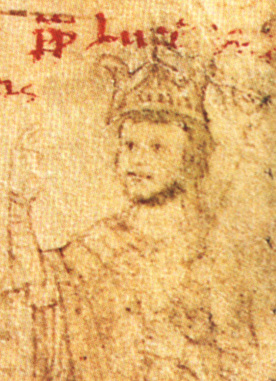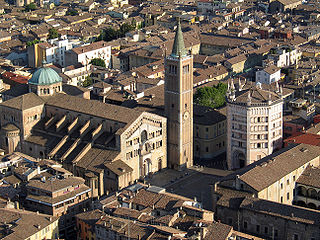
Canonization is the declaration of a deceased person as an officially recognized saint, specifically, the official act of a Christian communion declaring a person worthy of public veneration and entering their name in the canon catalogue of saints, or authorized list of that communion's recognized saints.

Pope Alexander III, born Roland, was head of the Catholic Church and ruler of the Papal States from 7 September 1159 until his death in 1181.

Pope Innocent IV, born Sinibaldo Fieschi, was head of the Catholic Church and ruler of the Papal States from 25 June 1243 to his death in 1254.

Pope Lucius III, born Ubaldo Allucingoli, reigned from 1 September 1181 to his death in 1185. Born of an aristocratic family of Lucca, prior to being elected pope, he had a long career as a papal diplomat. His papacy was marked by conflicts with Holy Roman Emperor Frederick I, his exile from Rome and the initial preparations for the Third Crusade.
Pope Lucius II, born Gherardo Caccianemici dal Orso, was head of the Catholic Church and ruler of the Papal States from 9 March 1144 to his death in 1145. His pontificate was notable for the unrest in Rome associated with the Commune of Rome and its attempts to wrest control of the city from the papacy. He supported Empress Matilda's claim to England in the Anarchy, and had a tense relationship with King Roger II of Sicily.

Wincenty Kadłubek was a Polish Catholic prelate and professed Cistercian who served as the Bishop of Kraków from 1208 until his resignation in 1218. His episcopal mission was to reform the diocesan priests to ensure their holiness and invigorate the faithful and cultivate greater participation in ecclesial affairs on their part. Wincenty was much more than just a bishop; he was a leading scholar in Poland from the twelfth and thirteenth centuries. He was also a lawyer, historian, church reformer, monk, magister, and the father of Polish culture and national identity.

Galdino della Sala, Galdinus or Galdimus, was a Roman Catholic saint from Milan in northern Italy. He was a cardinal elevated in 1165 and he also served as Archbishop of Milan from 1166 to his death in 1176. He was a staunch supporter both of Pope Alexander III, and of Milan and its neighbours in Lombardy, in their joint and parallel struggles against the Antipope Victor IV, supported by Holy Roman Emperor Frederick I Barbarossa.

Anselm of Lucca, born Anselm of Baggio, was a medieval bishop of Lucca in Italy and a prominent figure in the Investiture Controversy amid the fighting in central Italy between Matilda, countess of Tuscany, and Emperor Henry IV. His uncle Anselm preceded him as bishop of Lucca before being elected to the papacy as Pope Alexander II; owing to this, he is sometimes distinguished as Anselm the Younger or Anselm II.

Bruno di Segni was an Italian Roman Catholic prelate and professed member from the Order of Saint Benedict who served as the Bishop of Segni and the Abbot of Montecassino. He studied under the Benedictines in Bologna before being appointed a canon of the cathedral chapter of Siena. He was invited to Rome where he became a bishop and counselled four consecutive popes. He served as an abbot in Montecassino but his chastising Pope Paschal II on the Concordat of Ponte Mammolo in 1111 prompted the pope to relieve him of his duties as abbot and order Bruno to return to his diocese, where he died just over a decade later. Bruno's canonization was celebrated on 5 September 1181 under Pope Lucius III who presided over the celebration in the late bishop's diocese.

The Roman Catholic Suburbicarian Diocese of Ostia is an ecclesiastical territory located within the Metropolitan City of Rome in Italy. It is one of the seven suburbicarian dioceses. The incumbent Bishop is cardinal Giovanni Battista Re. Since 1150, its bishop has been the Dean of the College of Cardinals, Its Cathedral is Basilica di Sant'Aurea.

The Roman Catholic Suburbicarian Diocese of Palestrina is a Roman Catholic suburbicarian diocese centered on the comune of Palestrina in Italy.
The Roman Catholic Suburbicarian Diocese of Velletri–Segni is one of the suburbicarian dioceses, Catholic dioceses in Italy close to Rome with a special status and a cardinal bishop, the bishop of Velletri–Segni. Historically, the see of Velletri was combined with the see of Ostia from 1060 to 1914.
Ubaldo Caccianemici was an Italian cardinal and cardinal-nephew of Pope Lucius II, his cousin who elevated him in May or June 1144.

The Italian Catholic Diocese of Parma has properly been called Diocese of Parma-Fontevivo since 1892. The bishop's seat is in Parma Cathedral. The diocese is a suffragan of the Archdiocese of Modena-Nonantola.
The 1144 papal election followed the death of Pope Celestine II and resulted in the election of Pope Lucius II.
Pope Lucius II (1144–1145) created eleven cardinals in two consistories.

Amico Agnifili was an Italian Roman Catholic bishop and cardinal.

Giuseppe Guarino was an Italian Roman Catholic prelate and cardinal who served as the Archbishop of Messina from 1875 until his death. He was also the founder of the Apostoli della Sacra Famiglia. Guarino dedicated himself to proper religious formation for both priests and nuns while serving in both Siracusa and Messina and was known for reigniting the faith in those who were considered cut off from the faith.
The Foscari were an ancient Venetian patrician family.

Ardicio de Rivoltela was a cardinal of the Roman Catholic Church. He was a native of Piadena (Platina), in the diocese of Cremona in Lombardy. The appellation "de Rivoltela" is mentioned only once, and its significance is unclear.














